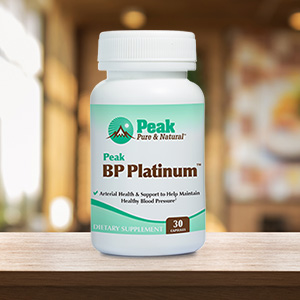Get Easy Health Digest™ in your inbox and don’t miss a thing when you subscribe today. Plus, get the free bonus report, Mother Nature’s Tips, Tricks and Remedies for Cholesterol, Blood Pressure & Blood Sugar as my way of saying welcome to the community!
High blood pressure at middle age means brain problems in old age

If you’re like most, you figure you won’t really have to worry about hypertension until you’re well into your 50s or 60s. That’s a mistake that could set you up for stroke and dementia. New research says controlling your blood pressure is a “long game,” and we’d all be wise to start paying attention now…
But most people I know who are in their 40s and even their early 50s aren’t losing too much sleep worrying about their blood pressure.
If you’re in that age group, and without a family history of hypertension, chances are you get your annual physical and, if everything looks OK, you don’t think about it too much after that.
That needs to change right now because recent research has uncovered a connection between high blood pressure before age 60 and brain damage later in life…
White matter changes predict high blood pressure
The subjects of this study were 37,041 people aged 40 to 69 who were enrolled in the UK Biobank, a major long-term study that began in 2006 to examine various factors that contribute to disease over time.
Dr. Karolina Wartolowska headed the study. She is a clinical research fellow at the Centre for Prevention of Stroke and Dementia at the University of Oxford in Great Britain.
In particular, the study looked for a type of damage in the brain called “white matter hyperintensities” (WMH). These WMHs show up on an MRI scan as bright white spots.
These lesions on the white matter of the brain indicate damage to small blood vessels, and are associated with an increased risk of stroke, dementia, physical disabilities, depression, and a decline in thinking abilities.
Dr. Wartolowska notes that not all people develop these changes as they age, but that they are present in more than 50 percent of patients over the age of 65 and are more likely to develop with higher blood pressure and more likely to become severe.
Even slight hypertension is dangerous
“We made two important findings,” says Dr. Wartolowska.
The first involves changes in diastolic blood pressure, the bottom number of your blood pressure reading, which reflects your blood pressure between heartbeats.
Many people don’t realize that this number is just as important as your systolic pressure (the top number).
Changes in diastolic blood pressure in people in their 40s and 50s were strongly associated with more extensive brain damage years later, even if the reading was only 90 (barely above the “normal” 80 for diastolic pressure).
Related: Why ‘normal’ blood pressure readings set you up for a false send of security
The second important finding was that any increase in blood pressure beyond the normal range is associated with a higher amount of white matter hyperintensities.
This suggests that even slightly elevated blood pressure, even before it meets the criteria for being treated as hypertension, has a damaging effect on brain tissue.
«SPONSORED»
Why does this happen?
White matter lesions are caused by changes in water content and fluid movement that occur in brain tissue when the brain cells are inflamed or damaged, such as happens in a small stroke.
It is thought that elevated pressure in the brain over time causes damage to blood vessels and makes the blood vessel linings leak.
Another possibility is that elevated blood pressure between heartbeats (diastolic pressure) causes larger blood vessels to stiffen. This causes blood flow that is too low between heartbeats, resulting in brain damage.
4 foods you should add to your diet now
1. Yogurt. Research shows that the beneficial bacteria in yogurt could replace some of the “good” germs that are killed off by the salt in our diets.
2. Sweet potatoes. Alsoavocados, spinach, beans and bananas. These high potassium foods can prompt the kidneys to expel more sodium, helping to regulate blood pressure.
3. Put olive oil on your greens. The combination of olive oil and certain vegetables, such as spinach, leads to a reaction between the unsaturated fats in the olive oil and certain nitrites in the vegetables to create nitro fatty acids. These fatty acid compounds have been found to relax blood vessels and lower blood pressure.
4. Hibiscus tea. A review of studies published in the Journal of Hypertension found that the daily use of hibiscus tea reduced systolic blood pressure by an average of 7.5mmHG and diastolic pressure by an average of 3.53mmHg.
Editor’s note: Are you feeling unusually tired? You may think this is normal aging, but the problem could be your master hormone. When it’s not working, your risk of age-related diseases skyrockets. To reset what many call “the trigger for all disease” and live better, longer, click here to discover The Insulin Factor: How to Repair Your Body’s Master Controller and Conquer Chronic Disease!
Sources:
High Blood Pressure in Midlife Is Linked to Increased Brain Damage in Later Life — neurosciencenews.com
40 Ways to Lower Your Blood Pressure After 40 — bestlifeonline.com
White Spots on the Brain in an MRI — verywellhealth.com
A daily helping of bio-live yogurt or sauerkraut could lower high blood pressure and cut the risk of a stroke or heart attack – even if you have a salty diet — dailymail.co.uk
Protection from hypertension in mice by the Mediterranean diet is mediated by nitro fatty acid inhibition of soluble epoxide hydrolase — PNAS (Proceedings of the National Academy of Sciences)
Effect of sour tea (Hibiscus sabdariffa L.) on arterial hypertension a systematic review and meta-analysis of randomized controlled trials — Journal of Hypertension













